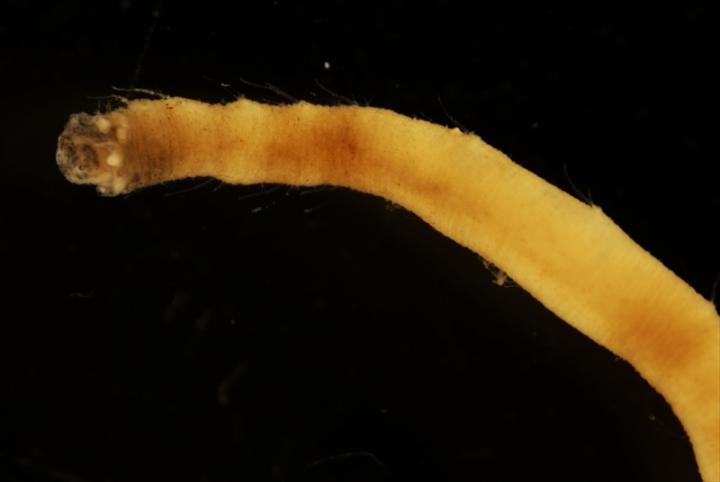
Credit: Naoto Jimi, National Institute of Polar Research, Japan
Earlier this year, a team from Japan’s National Institute of Polar Research (NIPR), National Museum of Nature and Science (NMNS), and Kochi University (KU) set out to collect specimens of sea worm near the South Orkney Islands, a remote region of the Southern Ocean about 400 miles northeast of the tip of the Antarctic Peninsula.
The researchers collected material from the sea floor at depths of 2,036 to 2,479 meters, a segment that falls within what oceanographers call the bathyal zone (1,000 to 4,000 meters deep). Amid the collected seafloor material, they observed a new Acrocirridae Banse, a family that now includes 43 species of worm, all but two of which are bottom dwelling. The team, led by Naoto Jimi, a postdoctoral fellow at NIPR, published their findings in Biodiversity Data Journal on June 8, 2020.
The team’s process involved extracting rock and silt sediments using a sieve with seawater and fixing them in an ethanol solution. They observed a variety of captured specimens under a microscope and photographed them with a high-resolution digital SLR. The newly-identified worm is named “Flabelligena Gillet, 2001.”
Flabelligena Gillet, 2001 falls within the broad class of worms called polychaetes, which contains over 10,000 species. “Polychaetes are one of the most diverse groups in marine benthic animals and well-studied in the Southern Ocean,” Jimi said. “Many researchers have investigated the Southern Ocean, but our knowledge of small deep-sea invertebrates is still quite limited.”
Jimi and his NIPR, NMNS, KU co-authors described the Flabelligena Gillet, 2001as having a “minute” body, body papillae (small rounded protuberance), 1-3 pairs of branchiae (gill-like organs), and a pair of frontal palps (segmented appendages usually associated with touch or taste). Its body is about 1.8 centimeters long and 1 millimeter wide and rounded on both ends.
The new species of worm is now one of six described species of Flabelligena, which are known mainly from the North Atlantic Ocean. Three species of Flabelligena are from the Southwest Atlantic, Mediterranean, and South Indian Oceans. They all live in sandy mud areas, mainly in the bathyal to abyssal depths (1,000 meters and deeper). According to Jimi, the new species are the first records of Flabelligena found in the Southern Ocean. The discovery of team will also contribute dramatically to the understanding of biodiversity of the Antarctic region.
Jimi and his team hope to discover more species and continue to learn more about the vast Southern Ocean. “This is just the first step in understanding the biodiversity of the Antarctic Ocean,” Jimi said. “The next step is to understand the polychaete diversity around Syowa Station.
Syowa Station is Japan’s Antarctic research station located in East Ongul Island, Antarctica.
###
About National Institute of Polar Research (NIPR)
The NIPR engages in comprehensive research via observation stations in Arctic and Antarctica. As a member of the Research Organization of Information and Systems (ROIS), the NIPR provides researchers throughout Japan with infrastructure support for Arctic and Antarctic observations, plans and implements Japan’s Antarctic observation projects, and conducts Arctic researches of various scientific fields such as the atmosphere, ice sheets, the ecosystem, the upper atmosphere, the aurora and the Earth’s magnetic field. In addition to the research projects, the NIPR also organizes the Japanese Antarctic Research Expedition and manages samples and data obtained during such expeditions and projects. As a core institution in researches of the polar regions, the NIPR also offers graduate students with a global perspective on originality through its doctoral program. For more information about the NIPR, please visit: https:/
About the Research Organization of Information and Systems (ROIS)
The Research Organization of Information and Systems (ROIS) is a parent organization of four national institutes (National Institute of Polar Research, National Institute of Informatics, the Institute of Statistical Mathematics and National Institute of Genetics) and the Joint Support-Center for Data Science Research. It is ROIS’s mission to promote integrated, cutting-edge research that goes beyond the barriers of these institutions, in addition to facilitating their research activities, as members of inter-university research institutes.
Media Contact
Public Relations Section, NIPR
[email protected]
Related Journal Article
http://dx.




